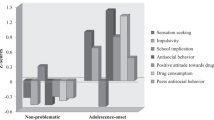Abstract
Retrospective and prospective reports of the onset of disruptive child behaviors were analyzed in a sample of clinic-referred boys. The younger boys (ages 7–9 years), compared with the older boys (ages 10–12 years), showed the highest level of disruptive behavior and, judging from mothers' reports, had the fastest progression of onsets from less serious to more serious problem behaviors. Despite some overlap, developmental sequences in problem behavior within the domains of hyperactivity/inattention, oppositional behavior, and conduct problems were similar across the two age groups. This was also the case for developmental sequences of overt or confrontive problem behaviors and covert or concealing conduct problems. Sequences of the onset of oppositional behavior and conduct problems were validated through prospective data, based on the information from mothers, teachers, and boys themselves. The implications of the findings are discussed for the formulation of developmental pathways of behavior and the analysis of causal factors.
Similar content being viewed by others
References
American Psychiatric Association. (1980).Diagnostic and statistical manual of mental disorders. (3rd ed.). Washington, DC: Author.
American Psychiatric Association. (1987).Diagnostic and statistic manual for mental disorders. (3rd ed. rev.). Washington, DC: Author.
August, G. J., & Stewart, M. A. (1982). Is there a syndrome of pure hyperactivity?British Journal of Psychiatry, 140 305–311.
Barkley, R. A. (1989). Attention deficit-hyperactivity disorder. In E. J. Mash & R. A. Barkley (Eds.),Treatment of childhood disorders (pp. 39–72). New York: Guilford Press.
Barkley, R. A., Fischer, M., Newby, R. F., & Breen, M. J. (1988). Development of a multimethod clinical protocol for assessing stimulant drug response in children with attention deficit disorder.Journal of Clinical Child Psychology, 17 14–24.
Behar, D., & Stewart, M. A. (1982). Aggressive conduct disorder of children: The clinical history and direct observations.Acta Psychiatrica Scandinavia, 65 210–220.
Costello, A. J., Edelbrock, C., Dulcan, M. K., Kalas, R., & Klaric, S. (1987).Diagnostic Interview Schedule for Children (DISC). Pittsburgh, PA: Western Psychiatric Institute and Clinic, School of Medicine, University of Pittsburgh, Pittsburgh, PA.
Farrington, D. P., Loeber, R., Elliott, D. S., Hawkins, J. D., Kandel, D. B., Klein, M. W., McCord, J., Rowe, D. C., & Tremblay, R. E. (1990). Advancing knowledge about the onset of delinquency and crime. In B. B. Lahey & A. E. Kazdin (Eds.),Advances in clinical child psychology (Vol. 13, pp. 284–342). New York: Plenum Press.
Farrington, D. P., Loeber, R., & Van Kammen, W. B. (1990). Long term criminal outcomes of hyperactivity-impulsivity-attention deficit and conduct problems in childhood. In L. N. Robins & M. Rutter (Eds.),Straight and devious pathways from childhood to adulthood (pp. 62–81). New York: Cambridge University Press.
Green, S. M., Loeber, R., & Lahey, B. B. (1991). The stability of mothers' recall of age at onset of their child's attention and hyperactivity problems.Journal of the American Academy of Child and Adolescent Psychiatry, 30 135–137.
Jacobson, R. R. (1985). The subclassification of child firesetters.Journal of Child Psychology and Psychiatry and Allied Disciplines, 26 769–775.
Kandel, D. B. (1978). Convergence in prospective longitudinal surveys of drug use in normal populations. In D. B. Kandel (Ed.),Longitudinal research on drug use (pp. 3–38). New York: Wiley.
Kandel, D. B., & Faust, R. (1975). Sequence and stages in patterns of adolescent drug use.Archives in General Psychiatry, 32 923–932.
Lahey, B. B., Loeber, R., Stouthamer-Loeber, M., Christ, M. A. G., Green, S. M., Russo, M. F., Frick, P. J., & Dulcan, M. (1990). Comparison of DSM-III and DSM-III-R diagnoses for prepubertal children: Changes in prevalence and validity.Journal of the American Academy of Child and Adolescent Psychiatry, 29 620–626.
Loeber, R. (1988). Behavioral precursors and accelerators of delinquency. In W. Buikhuisen & S. A. Mednick (Eds.),Explaining crime (pp. 51–67). Leiden: Brill.
Loeber, R. (1990). Development and risk factors of juvenile antisocial behavior and delinquency.Clinical Psychology Review, 10 1–41.
Loeber, R., & Baicker-McKee, C. (1990).The changing manifestations of disruptive/antisocial behavior from childhood to early adulthood: Evolution or tautology. Unpublished manuscript. Western Psychiatric Institute and Clinic, School of Medicine, University of Pittsburgh, Pittsburgh, PA.
Loeber, R., Brinthaupt, V., & Green, S. M. (1990). Attention deficits, impulsivity and hyperactivity with or without conduct problems: Relationships to delinquency and unique contextual factors. In R. J. MacMahon & R. D. Peters (Eds.),Behavior disorders of adolescence: Research, intervention and policy in clinical and school settings (pp. 39–61). New York: Plenum Press.
Loeber, R., & Le Blanc, M. (1990). Toward a developmental criminology. In N. Morris & M. Tonry (Eds.),Crime and justice (Vol. 12, pp. 375–473). Chicago: University of Chicago Press.
Loeber, R., Stouthamer-Loeber, M., Van Kammen, W. B., & Farrington, D. P. (1991).Childhood origins of antisocial behavior, substance use, and psychopathology. Unpublished paper. Western Psychiatric Institute and Clinic, School of Medicine, University of Pittsburgh, Pittsburgh, PA.
McGee, R., Williams, S., & Silva, P. A. (1984). Behavioral and developmental characteristics of aggressive, hyperactive and aggressive-hyperactive boys.Journal of the American Academy of Child Psychiatry, 23 270–279.
Offord, D. R., Sullivan, K., Allen, N., & Abrams, N. (1979). Delinquency and hyperactivity.Journal of Nervous and Mental Disorders, 167 734–741.
Patterson, G. R. (1982).A social learning approach: Coercive family process. Eugene, OR: Castalia Publishing Company.
Radke-Yarrow, M., Campbell, J. D., & Burton, R. V. (1970). Reliability of maternal retrospection: A preliminary report. In K. Danziger (Ed.),Readings in child socialization. Oxford: Pergamon.
Stewart, M. A., Copeland, L. E., & deBlois, C. S. (1988). Age of onset of aggressive conduct disorder: A pilot study.Child Psychiatry and Human Development, 19 126–131.
Sullivan, A., Kelso, J., & Stewart, M. (1990). Mothers' view on the ages of onset for four childhood disorders.Child Psychiatry and Human Development, 20 269–278.
Walker, J. L., Lahey, B. B., Hynd, G. W., & Frame, C. L. (1987). Comparison of specific patterns of antisocial behavior in children with conduct disorder with or without coexisting hyperactivity.Journal of Consulting and Clinical Psychology, 55 910–913.
Author information
Authors and Affiliations
Rights and permissions
About this article
Cite this article
Loeber, R., Green, S.M., Lahey, B.B. et al. Developmental sequences in the age of onset of disruptive child behaviors. J Child Fam Stud 1, 21–41 (1992). https://doi.org/10.1007/BF01321340
Issue Date:
DOI: https://doi.org/10.1007/BF01321340




